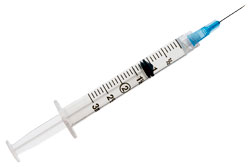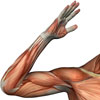- Introduction to botulinum toxin
- How does botulinum toxin work?
- What is botulinum toxin used for?
- What is involved in having a botulinum toxin injection?
- What are the possible side effects of a botulinum toxin injection?
- How much does botulinum toxin therapy cost?
Introduction to botulinum toxin
Botulinum toxin is a neurotoxin that is produced by the bacterium responsible for botulism, Clostridium botulinum. The name comes from the latin word for sausage (‘botulus’) and comes from a German physician who described the poisoning after the ingestion of sausage. The neurotoxin works by weakening the muscles and stopping them from contracting very well, which can lead to paralysis.
The commercial medical drug is a highly purified form of this toxin that can actually be very useful for lots of different medical conditions, not just the cosmetic ones for which it is better known. Some of these are neurological conditions due to muscles being too tight or overcontracted, while it can also be helpful in some other medical indications such as excessive sweating and drooling.
How does botulinum toxin work?
The therapeutic effects of the neurotoxin have been known for some time now with the first clinical use of the preparation in strabismus, or squint, in the 1970’s. There are two commercially available forms of the most common preparation, botulinum toxin type A, in Australia. They are BotoxTM (Allergan pharmaceuticals) and DysportTM (Ipsen pharmaceuticals). The term ‘botox’ is often used interchangeably with botulinum toxin, but this can be problematic given the very different equivalent doses available of these two common preparations.
The preparations are purified forms of the toxin, and contain rather minute quantities of the toxin produced by the bacterium. Usually, the infection that produces this toxin, botulism, is quite serious and can cause weakness and even paralysis. The toxin does this by stopping the nerve fibres that control muscles from working the way they normally do. Usually, nerves release a chemical called acetylcholine from its endings which signals the muscle to contract. Botulinum toxin stops this substance from being released, and so the muscle does not contract. While this action is dangerous if released by infection, when purified and injected, it can be incredibly useful in diseases where the muscles are too tight/overcontracted, or where doctors want to stop the release of acetylcholine.
By making sure the injections are in just the right spot, botulinum toxin can provide very effective treatment for lots of conditions with very few side effects. Although the weakening of the muscle is felt to be important, some recent research suggests that some conditions like dystonia, which is an involuntary tightening of muscle, may be the result of abnormal incoming signals from nerves and muscle. This has led to recent thinking that the toxin may exert its beneficial effect by interrupting these incoming signals to the brain as well.
What is botulinum toxin used for?

Botulinum toxin is indicated for:
- Hemifacial spasm*;
- Blepharospasm*;
- Cervical dystonia/torticollis*;
- Spasticity: Cerebral palsy and stroke upper* and lower limb, other cerebral and spinal disorders (e.g. multiple sclerosis);
- Other focal dystonia (e.g. writer’s cramp, oromandibular dystonia);
- Tremor;
- Strabismus;
- Spasmodic dysphonia;
- Hypersecretory disorders: Primary (axillary) hyperhidrosis*, hypersalivation (e.g. in Parkinson’s disease);
- Bladder: Detrusor-sphincter dyssynergy and detrusor instability;
- Headache: Tension and migraine;
* PBS-subsidised indications
Blepharospasm
Blepharospasm refers to a spasming eyelid (‘blephara’ being the eyelid and spasm meaning rapid movement). This can be a very unpleasant condition for a sufferer. Patients complain of repetitive blinking and sometimes, an inability to keep the eyes open.
To treat this, very small amounts of botulinum toxin can be injected through a very fine needle into the eyelids. This partially paralyses the muscle and provides great relief.
Hemifacial spasm
Hemifacial spasm is similar to blepharospasm, with an involuntary contraction of the muscles of the face on one side. The most frequently identified cause is a small loop of an arterial vessel just inside the base of the skull, which is pressing on the facial nerve which controls those facial muscles. Once again, injections around the eye and sometimes also the lower face can help.
Cervical dystonia
Cervical dystonia means abnormally high muscle tone (dystonia) in the neck (cervical) and can result in various positions of the head. Some of these may involve the neck being rotated and pulled in a certain direction or down towards the chest. This condition is also sometimes called torticollis or ‘wry neck’.
The injection partially paralyses the muscle and frees up movement of both the neck and also the shoulders. In this case, the toxin is usually injected with the help of an electromyography (EMG) machine that can sense the electrical currents of muscles to make sure that it is being injected in exactly the right spot.
Other dystonias
Like with cervical dystonia, other muscles can also have ‘abnormal tone’ and be too tight. This can limit the amount of movement that is possible. By injecting these muscles with botulinum toxin, they can be freed up and allowed to move more, providing effective treatment for dystonias.
Spasticity

Drooling in cerebral palsy and Parkinson’s disease
In children with cerebral palsy and in adults with Parkinson’s disease, there is often excessive drooling, and this can be helped by injecting botulinum toxin into the salivary glands beneath the jaw and on the side of the face that produce the saliva. Often, there is not actually an excess of saliva produced, but a lack of swallowing which normally clears saliva. Acetylcholine (the substance that botulinum toxin blocks) not only controls muscles but also controls the salivary glands and tells them to produce saliva. The toxin basically lowers the drive to create saliva and so can prevent drooling with few side effects.
Hyperhidrosis
Hyperhidrosis means there is an excessive production of sweat from the glands in the skin, which can be very troublesome for some. Acetylcholine is also produced by nerves and stimulates sweat production in the skin; therefore it can be blocked with toxin. Botulinum toxin for primary axillary hyperhidrosis is covered by the PBS if injected by a neurologist for example, and after 1 to 2 months of a trial of topical aluminium preparation.
Other
Other conditions that can be treated with botulinum toxin include ‘spasmodic dysphonia’ (where the muscles that control speech in the voice box become too tight), tremor, some hyperactive bladder disorders, and occasionally even headache.
What is involved in having a botulinum toxin injection?
A botulinum toxin injection is usually a quick and relatively simple procedure that can be done in a doctor’s office. Firstly, the area for injection will be cleaned. There may be a little pain or pressure associated with the injection related to the needle and fluid itself, but a local anaesthetic agent is usually not required. The actual injection is just like having a vaccination shot, with a smaller amount of liquid being injected into the desired area.
The effects (both the good and bad if present) can be variable but wear off in time (usually within 3-4 months) and so the injection will probably have to be repeated then.
No preparation is needed before you go to have an injection. If you are using a drug that thins the blood aside from aspirin, the clinician may wish to know.
What are the possible side effects of a botulinum toxin injection?

Often after injection, there can be a little bit of excessive weakness in the muscles and if injected into an area like the neck can result in difficulties in swallowing, speaking and even cause noisy breathing. This is because the injection has found its way into some other areas which is sometimes difficult to avoid because of the anatomy.
More general side-effects can include some pain around the site of injection, a rash, some itchiness, headache and tiredness. There may also occasionally may be flu-like symptoms which are usually short-lived.
Aside from the above, there are some serious side effects of botulinum toxin injections but they are exceedingly rare.
Botulinum toxin is generally avoided during pregnancy, as is breastfeeding in the days following an injection.
How much does botulinum toxin therapy cost?
In Australia, the Phamaceutical Benefits Scheme (PBS) fully subsidises the cost of the toxin preparation for only the conditions blepharospasm, hemifacial spasm, torticollis and primary axillary hyperhidrosis (see above). In addition, the doctor may levy a charge for the injection procedure itself, which may or may not be part or fully recompensable under the Medicare Benefit Schedule (MBS) depending on the procedure.
Article kindly reviewed by:
Associate Professor Karl Ng MB BS (Hons I) FRCP FRACP PhD CCT Clinical Neurophysiology (UK) Consultant Neurologist – Sydney North Neurology and Neurophysiology (download referral form and map); Conjoint Associate Professor – Sydney Medical School, University of Sydney; and Editorial Advisory Board Member of the Virtual Neuro Centre.
More information
 |
For more information on neurological disorders that affect movement, and their treatments, see Neurological Rehabilitation and Movement Disorders. |
References
General references
- Moore P, Naumann M (eds). Handbook of Botulinum Toxin Treatment (2nd edition). Wiley-Blackwell; 2003.
- Brin MF, Albany K, Alexander D, et al. Spasticity: Etiology, evaluation, management, and the role of botulinum toxin type A. Muscle Nerve Suppl. 1997; 20(S6): 1-231. [Abstract]
Specific references
- Allergan Australia. Product Information: Botox. Gordon, New South Wales: Allergan Australia Pty Ltd; 2008.
- Ng K, Jones S. The “enhanced N35” somatosensory evoked potential: Its associations and potential utility in the clinical evaluation of dystonia and myoclonus. J Neurol. 2007;254(1):46-52. [Abstract]
- Ramachandran T. Botulinum toxin: Dystonia treatment [online]. WebMD [cited 6 January 2008]. Available from: [URL link]
- Vaile L, Finlay F. Is injection of botulinum toxin type A effective in the treatment of drooling in children with cerebral palsy? Arch Dis Child. 2006;91(10):862-3. [Abstract | Full text]
- Medicare Benefits Schedule. Department of Health and Ageing, Australian Government; 1 November 2007.
- Jankovic J. Botulinum toxin in movement disorders. Curr Opin Neurol. 1994;7(4):358-66. [Abstract]
- Priori A, Berardelli A, Mercuri B, et al. Physiological effects produced by botulinum toxin treatment of upper limb dystonia: Changes in reciprocal inhibition between forearm muscles.
Brain. 1995;118(Pt 3):801-7. [Abstract] - Yoshimura DM, Aminoff MJ, Tami TA, et al. Treatment of hemifacial spasm with botulinum toxin. Muscle Nerve. 1992;15(9):1045-9. [Abstract]
- Comella CL, Buchman AS, Tanner CM, et al. Botulinum toxin injection for spasmodic torticollis: Increased magnitude of benefit with electromyographic assistance. Neurology. 1992;42(4):878-82. [Abstract]
- Snow BJ, Tsui JK, Bhatt MH, et al. Treatment of spasticity with botulinum toxin: A double-blind study. Ann Neurol. 1990;28(4):512-5. [Abstract]
- Whurr R, Lorch M, Fontana H, et al. The use of botulinum toxin in the treatment of adductor spasmodic dysphonia. J Neurol Neurosurg Psychiatry. 1993;56:526-30. [Abstract | Full text]
- Grunfeld A, Murray CA, Solish N. Botulinum toxin for hyperhidrosis: A review. Am J Clin Dermatol. 2009;10(2):87-102. [Abstract]
- Morrisroe SN, Chancellor MB. Botulinum toxin use in the lower urinary tract. ScientificWorldJournal. 2007;7:808-17. [Abstract]
- Jankovic J, Schwartz K. Response and immunoresistance to botulinum toxin injections. Neurology. 1995;45(9):1743-6. [Abstract]
- Kumar KR, Ng K. Reduced facial nerve hyperexcitability from contralateral cerebral stroke in hemifacial spasm. Mov Disord. 2010;25(9):1310-2. [Abstract]
This treatment is used for the following diseases:
All content and media on the HealthEngine Blog is created and published online for informational purposes only. It is not intended to be a substitute for professional medical advice and should not be relied on as health or personal advice. Always seek the guidance of your doctor or other qualified health professional with any questions you may have regarding your health or a medical condition. Never disregard the advice of a medical professional, or delay in seeking it because of something you have read on this Website. If you think you may have a medical emergency, call your doctor, go to the nearest hospital emergency department, or call the emergency services immediately.







